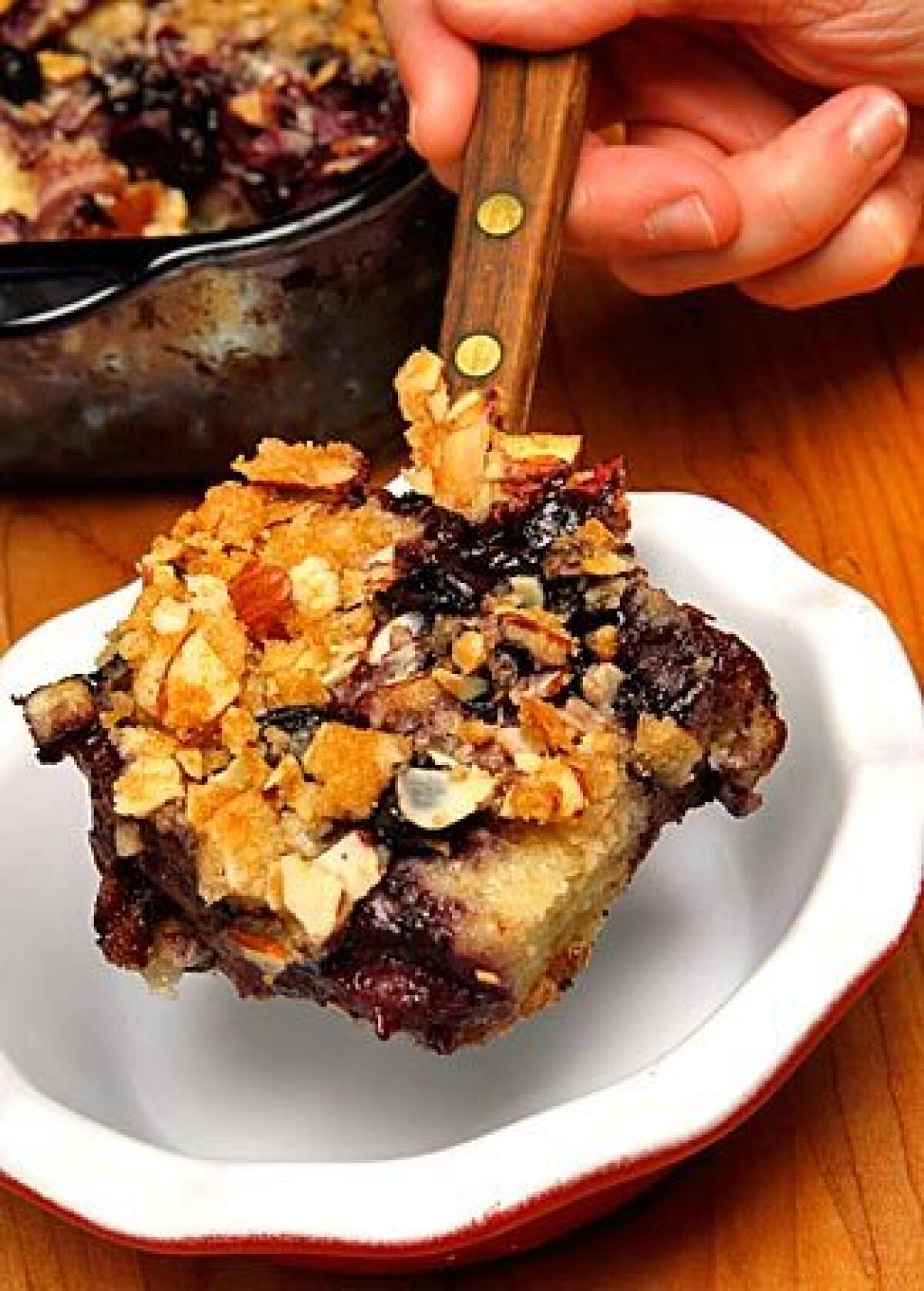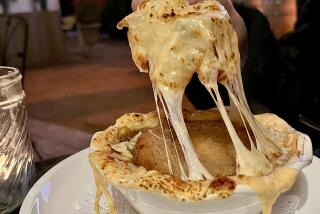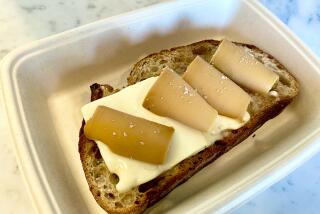French toast: the classic and the custom-made

I admit it. I’ve had a lifelong love affair with French toast.
When I was a kid, there was a simple magic to it: The way the soaked bread would puff in the pan, the toast crisping to a rich, golden brown in the hot fat. Fresh out of the pan, the dish was topped with a sprinkling of powdered sugar, like a dusting of fresh snow. This was dessert for breakfast — it almost felt wrong. With each bite, the crisp, almost brittle crust would give way to a tender, soft-as-a-pillow interior, subtle with hints of cinnamon and nutmeg and fragrant notes of vanilla.
As I started to cook for myself, it became a go-to recipe for its sheer ease and simplicity.
French toast remains a favorite breakfast choice. Done right, there’s an unpretentious beauty to this classic comfort food. But there is an art to French toast.
Sometimes there’s nothing as tempting as a plate of crisp, thick slices piled high on a plate with a sprinkling of sugar. But this is one dish that’s not limited to the classic presentation. Try soaking the toast overnight, then baking it as a casserole the next morning; the toast will swell like a soufflé in the oven as the scent of spiced custard fills the house. Or try stuffing the bread before frying, hiding a pocket of soft cheese, maybe chocolate or even a savory filling inside.
This is one dish that’s not limited to the skillet, or even the breakfast plate.
Classic French toast
Great French toast starts with the bread, but though almost any bread can be used in a French toast recipe, enriched breads with a loose structure, such as brioche or challah, are favorites. Still, whole-grain breads can give the toast an almost rustic appeal.
Slice the bread thick — about an inch— so there is still plenty of soft interior after the exterior of the bread crisps. Let the slices dry a little — dry bread, like a dry sponge, will absorb the custard batter more readily.
With the custard, it’s all about the ratio of dairy to eggs. Recipes will vary — a few eggs can be whisked with as little as a couple of tablespoons or as much as a cup of dairy. The more dairy, the lighter the custard; less dairy means a heavier, richer custard with the egg more prominent. And though milk works fine in the custard base, nothing beats the richness and silky texture of cream.
Add other flavors to the custard with a light hand, so as not to interfere too much with the toppings. Vanilla or almond extract will add a little richness, citrus zest will brighten the flavors and a dash of liqueur will add extra personality. A little spice — cinnamon, nutmeg — is classic, and a pinch of star anise, cardamom or allspice might add an exotic note. Or try a little chile powder, paprika or garlic for a savory take on the dish.
Leave the bread in the custard long enough to get soaked through but not completely saturated, maybe a couple of minutes on each side, depending on the bread. Then gently fry the bread in a hot skillet lightly coated with fat. Butter is traditional (and nothing beats the flavor of a little browned butter), though it can burn if not watched closely. Clarified butter or a neutral oil also works well. For more robust flavor, go with a hardier fat, such as bacon grease.
And though a skillet or griddle is the most common, it is by no means the only way to cook French toast. Try cooking it in a waffle iron or even a panini press (great for stuffed French toast). If using a skillet, make sure it is heavy enough to evenly heat, and cover the toast as it’s frying so it cooks evenly.
Baked French toast
French toast can also be baked. Bread slices are assembled in a baking dish with the custard poured over to soak. Baked like a casserole, the toast soufflés in the oven, still crisp but much more like a bread pudding in texture.
It’s a versatile dish. Bake the French toast with a light touch of spice, maybe a little vanilla or citrus zest, or play with the toppings and flavorings. Top the bread with diced fruit or berries, and add some chopped nuts, chocolate chips or a streusel topping. Add white chocolate to the custard base as a nod to white chocolate bread pudding.
For a savory take, eliminate the sugar and add diced sausage and mushrooms, onions or leeks. Add a little heat with chiles or diced peppers, and top with a grating of cheese.
Maybe the best thing about baked French toast is that virtually all the work is done ahead of time. Assemble the dish the night before to soak and refrigerate it. The next morning, remove the baking dish from the fridge as the oven heats so it can warm slightly (for even baking). Top the bread with whatever you want, then put it in the oven. In less than an hour, breakfast is ready. It’s a perfect dish when you have houseguests.
Stuffed French toast
There must be a reason stuffed French toast seems to be showing up on more menus lately. Maybe because you can never have too much of a good thing. Slices of battered bread are sandwiched around a variety of fillings —jams, cream cheese, mascarpone — before frying, then plated with a wide variety of sauces, glazes and toppings.
Methods vary, but the process is fairly simple: Use thinner slices of bread (as they will be thicker once joined together) and batter them as you would for classic French toast (batter on the outside of the sandwich only if you have a particularly moist filling). Then fill the sandwich. Use a thick jam or a fruit compote, try a flavored or herbed soft cheese or even a spread (Nutella, anyone?). Spoon the filling onto one side of the sandwich, leaving enough room around the edge so the filling does not spill out as the French toast cooks. Then gently fry over moderate heat, keeping the pan covered so the sandwich cooks evenly. Voilà.
And the method works great with savory fillings. Take what you have in the refrigerator and improvise — maybe a little caramelized onion, cheese, bacon and leftover dandelion greens. Make a savory egg batter and add grated Parmesan and cracked pepper, and batter both sides of sliced rustic sourdough. Layer one side with the caramelized onions, sliced Gruyère and crumbled bacon. Spoon a little mustard over the other slice and form the sandwich. Fry the stuffed toast until the bread is crisp and golden, and the cheese melts into the bacon and onion and just begins to ooze out of the side. Served with a tart salad and a glass of wine, it makes a perfect meal to close the day.
More to Read
Eat your way across L.A.
Get our weekly Tasting Notes newsletter for reviews, news and more.
You may occasionally receive promotional content from the Los Angeles Times.







